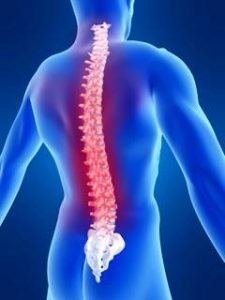NHS Pain Management is Failing
NHS pain management is failing, or
The true economic cost of pain-related issues
Most of our patients come to see us because of back pain or back-pain related issues such as neck pain, shoulder pain, sciatica, and headaches. Many see us for other musculoskeletal conditions. Most of them know that they have bad posture, are slouching, and are sitting too much or sitting in the wrong position. Most of them think this is somehow 'normal', that there's nothing they can do about it, or simply something they have to live with. While each case is individual, the common denominator is this: back pain has become an epidemic in the 21st century. It does not only affect the elderly; our patients are getting younger and younger, and we now see children with back pain problems. Not only does the pain limit quality of life for the individual, it has a grave impact on our society as a whole, from soaring NHS costs to severe economic loss.
Back pain: a ticking time bomb for the NHS
According to a recent article in The Times, the Scottish NHS's pain management strategy is failing. The NHS is unable to meet key targets across the sector. Audit Scotland found that the NHS is overspending on drug prescriptions and focusing on unsustainable short-term measures. While the total health budget increased by 2.7% last year to £12.2 billion, this is not enough to solve problems arising from soaring treatment costs and an inability to meet the needs of an ageing population. In particular, spending on drugs increased by more than 10% between 2012/13 and 2014/15, and the Scottish government predicts that this rise will continue by 5-10% each year. In light of these immediate pressures, the NHS is lacking the resources to meet key targets in accident and emergency waiting times, child mental health referrals, and cancer treatment, among other services [1].

Here are some staggering statistics on the economic cost of back pain:
The Office for National Statistics reports that in 2013, Sickness Absence accounted for a total of 131 million days lost [2]. While this is down from 178 million days in 1993, it is still a staggering number. The most common reason given was minor illnesses - common colds and coughs - accounting for 27.4 million days lost. The greatest number of days stood at 30 million days lost to the full range of musculoskeletal conditions, including 7.7 million days lost to back pain. In 2014, this number increased to 10 million days lost to back pain alone. This equals an economic cost of £1 billion in 2014, lost to back pain [3]. Around 4.2 million days were lost by workers aged 50-64. Those aged 25-34 missed 1.89 million days, and those aged 35-49 spent 3.86 million days at home - all due to back pain. And still, everybody thinks back pain is normal. The estimated cost of back pain across the EU stands at a staggering £200 billion each year [4].
Why short-term measures don't help
Over-the-counter medication does not fix the problem, nor does prescription medication. Yet both are the first choice of attack by both patients and GPs. Drugs only mask the underlying problem, and once the painkillers wear off, the pain returns, the patient returns to their GP, and a new - often stronger - prescription is issued. Oftentimes, our patients are taking a veritable cocktail of prescription and over-the-counter medication to alleviate their pain at least temporarily.
Patients, GPs, and even chiropractic associations such as the British Chiropractic Association (BCA), attribute the back pain epidemic to a couch-potato lifestyle. A sedentary lifestyle may indeed be behind the condition, and it is much more beneficial to get up and move or use a standing desk than spend the entire day confined to an office chair. However, as we have explained here, very often the underlying culprit is the seating arrangement (office chair, couch) than the number of time spent 'in the same position'. Sitting does cause twice as much pressure on the spine than standing, and an incorrect seat only aggravates this problem by pushing bones out of position forward. If bones go out of place forward, the body can't fix the problem by itself because it does not have any muscles that pull in the exact opposite direction. It has to compensate in other places, and that's why an incorrect seat can hurt your neck.
Changing lifestyle habits, changing the type of seat you use, and using a standing desk can make a big difference and can often alleviate existing symptoms. However, the best course of action for back pain or indeed any type of musculoskeletal problem is to address the underlying issue. Once the original problem is fixed, the body can heal out of symptoms permanently.
This last sentence is important. It sounds like common sense, and most of our new patients immediately nod in agreement when we explain this at their first visit. However, it is also their experience that permanent repair and relief has been an elusive concept to them prior to finding us.
Many of our patients find us as the last resort. They have tried physiotherapy (which mostly just prescribes exercises for one specific area of the body), chiropractic/osteopathy (which move any and all stuck joints in the areas where it hurts), or acupuncture. Most of them report that they found temporary relief but the symptoms returned after a few days or a few weeks. Our approach of Advanced Biostructural Correction™ is radically different.
Most musculoskeletal problems have an underlying origin in structural misalignments of the spine. Our bodies are like precision machines: all parts have to work together 24/7 to keep the entire body functioning and painfree. If one part goes out of place, the entire machine does not run smoothly anymore. Parts get affected by 'wear and tear', other parts get 'stuck', pressure increases, tension and torque get created, and the entire skeletal frame ends up distorted (which is the underlying cause of bad posture).

With Advanced Biostructural Correction™, we address the underlying structural problem. We see postural changes that the medical profession declares impossible - because they don't yet know the manoeuvres needed to achieve the results in question. We see people's humpbacks shrink, their goose-necks reduce (so their heads sit above their shoulders rather than in front), we see scoliosis even out. We see people's pains and aches disappear and their mobility return. We see our patients returning to work and picking up long-lost hobbies again.
The NHS's approach is short-term measures in the form of painkillers or a few sessions of physiotherapy where only one particular area of the body gets addressed. We consider the underlying cause of back pain issues, and we look at the entire body (not just where it hurts). The NHS's short-term measures cost a fortune and yet they often only provide temporary relief. We provide lasting results, not quick fixes which mask the problem so it returns a few days or weeks later. We are a private practice; our patients have to pay out of pocket for our service, and for many this is a considerable commitment. In return, our commitment is to provide the best possible care at the most affordable rate (talk to us about the different payment plans we offer).
In a world where back pain has become an epidemic with a huge impact on healthcare systems and the economy, it is becoming more and more important to address the underlying causes of musculoskeletal ailments. Most back pain conditions are preventable (due to better lifestyle habits), and they are certainly fixable. If you are suffering from back pain, neck pain, shoulder pain, hip pain, sciatica, or any other painful musculoskeletal condition, take advantage of our free 20 mins consultation. Talk to one of our practitioners to see how we can help you return to work, return to your hobbies, and find permanent relief instead of temporary quick-fixes which cost you lost work days and the nation a fortune in NHS costs.
[1] The Times, 'NHS Pain Management is Failing', 27 October 2016. http://www.thetimes.co.uk/article/nhs-pain-management-is-failing-x2629ctw6
[2] Office for National Statistics. 'Full Report: Sickness Absence in the Labour Market.' 25 February 2014.
[3] The Express. 'Exclusive: Millions of Working Days Lost to Back Pain - and it Costs us £1 Billion a Year.' 12 June 2015. http://www.express.co.uk/news/uk/583948/back-pain-experts
[4] The BBC. 'Is Back, Neck, and Muscle Pain Hurting the UK Economy?' 25 February 2014. http://www.bbc.com/news/business-26338889.

